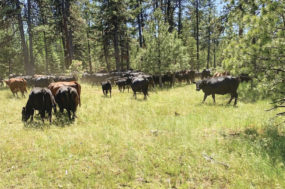On Aug. 5, the Environmental Protection Agency (EPA) spilled more than 3 million gallons of waste from the Gold King Mine into the Animas River near Durango, Colorado. The high amounts of minerals, including iron, zinc, copper and lead, have turned the river into an orange sludge.
The flow of the Animas River into the San Juan River has carried the waste into southern Utah and northern New Mexico. Farmers and ranchers across Colorado, Utah and New Mexico are now trying to survive without irrigation water and are extremely concerned for their livestock and crops.
Darrin Parmenter, the Colorado La Plata County extension agent, says the Animas River corridor is vital for agriculture production, making this incident an unpleasant situation. The various river uses range from livestock and alfalfa to nurseries and vegetable production.
“There are people who are upset,” Parmenter says. “Obviously, when you have potential contamination to the life-blood of Durango and La Plata County, people definitely get burned – and rightfully so.”
According to a report the EPA recently released, the amounts of individual toxins in the Animas River extremely exceed the acceptable levels set by the EPA. Because many Colorado producers use the river for irrigation purposes, Parmenter says producers have been calling, wanting to know when they can irrigate again and if the contaminated water will affect their soil.
“The producers just want to make sure that once they do introduce irrigation water back in those ditches that they’re not stirring up heavy metal that has settled,” Parmenter says. “Hopefully the EPA will have more answers – as far as irrigators are concerned.”
After Colorado Gov. John Hickenlooper declared a state of emergency, Colorado Cattlemen’s Association Director of Communications Paula Waggoner quickly used social media to notify member producers. She encouraged them to do research and find any potential issues or damages that can be caused by the spill.
“We have not had a producer call up and say ‘We’ve got a problem,’” Waggoner says. “So we’re just waiting to see how this thing unfolds.”
The Navajo Nation, which borders the San Juan River in southern Utah, also has declared the incident a disaster emergency.
Curtis Yanito, the head of a grazing committee near the San Juan River in southern Utah, has been encouraging Navajo livestock producers to remove their livestock from the pastures along the river.
“It has been really hard trying to get the livestock to move out of the thick brush,” Yanito says. “The people really love their livestock, and they have tears in their eyes because they are really upset about this spill.”
Yanito says that some producers can’t afford to relocate their livestock and they are just hoping for the best. Producers are also worried about being able to sell their livestock in the future.
“At auctions they are going to say ‘Hey, we can’t take those because of possible contamination,’” Yanito says. “Even if producers say they’ve taken care of it, there is always someone who rejects them.”
Yanito pointed out that this not only affects farmers and ranchers, but also the large amounts of wildlife in the area.
“There is a lot of deer down here,” Yanito says. “If they get infected and go back to the mountains, they’ll start contaminating up there.”
To help the local people survive this disaster, the Navajo Nation along with county officials in Colorado, Utah and New Mexico have been hauling clean water to citizens and filling up livestock watering tanks. ![]()
PHOTO: To protect their livestock, many producers in Colorado, Utah and New Mexico are removing their cattle from the pastures along the Animas River, which was contaminated by 3 million gallons of waste from the Gold King Mine. Photo by ThinkStock.







